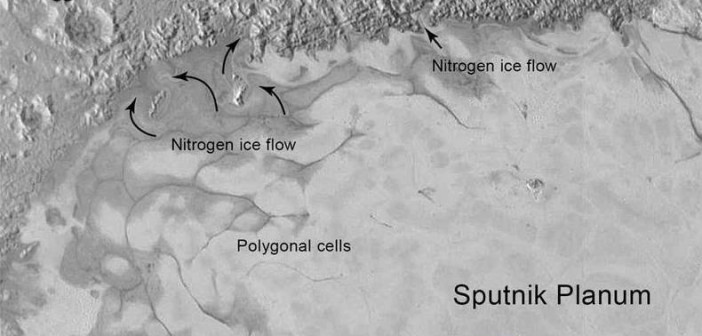New Horizons scientists Kelsi Singer and Alan Stern predicted that Pluto may have subsurface activity, in this study published even before New Horizon’s recent observations of Pluto’s strangely uncratered surface areas.
Where Does the Nitrogen Come From?
Pluto’s surface and atmosphere contain a significant amount of nitrogen, but the gas leaks out of Pluto’s atmosphere at an tremendous rate — estimated at about 1.5 × 1012-13 grams per year (roughly 200-2000 tons/hr!). But if the nitrogen has been escaping at this rate since the solar system was formed, the entire atmospheric reservoir of would have been lost long before now. So what is resupplying Pluto’s nitrogen?
Singer and Stern explore several possible sources:
- Delivery by comet impact
The authors calculate that over the 4-billion-year span since Pluto’s formation, it has been impacted by a total of 600 million comets of varying sizes, all likely containing nitrogen. But their estimates show that the amount of nitrogen this would supply falls several orders of magnitude shy of explaining the escape rate. - Excavation by cratering
Could comet impacts simply expose nitrogen buried in reservoirs just beneath Pluto’s surface? That method, too, falls short of resupplying atmospheric nitrogen escape by at least an order of magnitude, even using the most generous estimates. - Internal activity
Unless the believed atmospheric loss rate of Pluto is overestimated, the authors conclude that Pluto must experience some sort of internal activity such as cryovolcanism that brings nitrogen from below its surface up and into the atmosphere.
The Study in Context of Current Events
Singer and Stern wrote and submitted this paper before the New Horizons spacecraft’s recent flyby of Pluto. Data from this mission has recently provided surprise after surprise — from images of smooth, crater-free regions on Pluto’s surface to evidence of sheets of carbon monoxide, methane, and nitrogen ices flowing like glaciers.
These clues support Singer and Stern’s theories of internal activity, but raise new questions about the nature of that activity! As data from New Horizons keeps streaming in (in fact, atmospheric data from the Alice instrument is expected to pin down the atmospheric loss rate very soon), we can hope to continue to piece this picture together.
Citation:
Kelsi N. Singer and S. Alan Stern 2015 ApJ 808 L50 doi:10.1088/2041-8205/808/2/L50


1 Comment
Pingback: Allgemeines Live-Blog ab dem 3. August 2015 | Skyweek Zwei Punkt Null